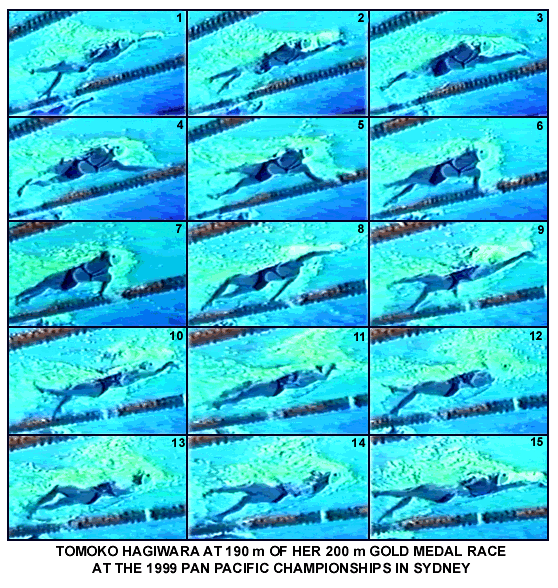HOW CHAMPIONS DO IT
Researched, produced, and prepared by Brent S. Rushall,
Ph.D., R.Psy.

TOMOKO HAGIWARA AT 190 m OF HER GOLD MEDAL 200 m BACKSTROKE RACE AT THE 1999 PAN PACIFIC CHAMPIONSHIPS IN SYDNEY
Each frame is .1 seconds apart. Tomoko Hagiwara's time for this 200-m swim was 2:11.36.
Notable Features
Frame #1: The right arm and hand enter. The arm is hyperextended at the elbow placing the hand wider than the upper arm orientation suggests. The swimmer's head is well back in the water and good overall streamline is exhibited. The left arm is near completion of its direct propulsive phase.
Frame #2: Typical of all top backstrokers, the swimmer has immediately oriented the hand of the right arm backward. The hyperextended elbow is unlocked. There is no downward movement after entry. The left arm begins to scull inward as the final phase of its pull. The overall streamline, which is maintained for the whole stroke, is very good. The right leg kick assists the hips and shoulders to roll to the right.
Frame #3: The right arm pull is powered by adduction of the upper arm. Not enough bend at the elbow is demonstrated. The forces produced here have a considerable lateral component. The left arm begins to exit the water thumb first.
Frame #4: A slight bend at the elbow in the right arm occurs as adduction still moves the arm to the side and backward. Shoulder and hip rotation is maximal. The left leg kicks to counterbalance forces generated by the right arm pull.
Frame #5: The wide sweeping right arm pull continues. This pull is weak, because the lever arm is long, and what force is produced, is compromised by a major lateral component. A more direct and stronger pull could have been developed had there been a much greater and earlier bend at the elbow. The left leg kick has contributed to the hips and shoulders flattening.
Frame #6: The wide right arm pull deepens. The left arm is past vertical and reaching backward over the water.
Frame #7: The right arm extends backward and deep.
Frame #8: The right arm begins its inward scull. The left arm enters with an undesirable elbow bend; the backstroke equivalent of the crawl stroke "dropped elbow." The arm will have to straighten and the hand to move directly sideways before any propulsive force can be developed. The left leg begins to kick to assist the hips and shoulders to rotate to the left.
Frame #9: The right arm inward scull nears completion. The left arm has straightened and the wrist has positioned the palm of the hand to begin developing propulsive forces. Shoulder and hip rotation continues as the left leg nears the completion of its kicking action.
Frame #10: Left arm propulsion increases as the upper arm is adducted and the elbow bends. The beginning of the major propulsive phase of the stroke can be seen as the hand and forearm are oriented backward.
Frame #11: The hand/forearm propulsive surface of the left is clearly visible. This arm also has insufficient flexion at the elbow. Adduction is powering the pull but the long, left-arm lever dilutes the potential propulsive forces because of the lateral feature of the movement. The swimmer's excellent streamline is clearly visible. The right leg kicks to counterbalance the lateral forces of the right arm pull.
Frame #12: The long propelling left arm is directly to the side of the swimmer. The right leg completes its kick.
Frame #13: The left arm continues its direct push backward. It does not go deep nor does it set-up for an inward scull like the right arm action. The left leg prepares to kick.
Frame #14: The left leg kicks to counterbalance the vertical force component of the left arm's extension that pushes back and down.
Frame #15: The left arm extends backward and avoids going deep. The right arm enters and the right leg begins to kick to assist shoulder and hip rotation to the right. The stroke cycle begins again with this position being similar to that exhibited in frame #2.
Tomoko Hagiwara's arm pulls would improve significantly if she increased the angle of elbow bend in both arms. That bend, which would be more than 90 degrees at mid pull, would allow the hand/forearm propelling surfaces to apply forces mostly backward and would reduce the current excessive amount of lateral force development in both arms.
The swimmer also displays excellent streamlining throughout the whole stroke. The effect of that consistent functional posture on resistance probably contributes substantially to her respectable performance time, despite her weak arm actions.

Return to Table of Contents for this section.




